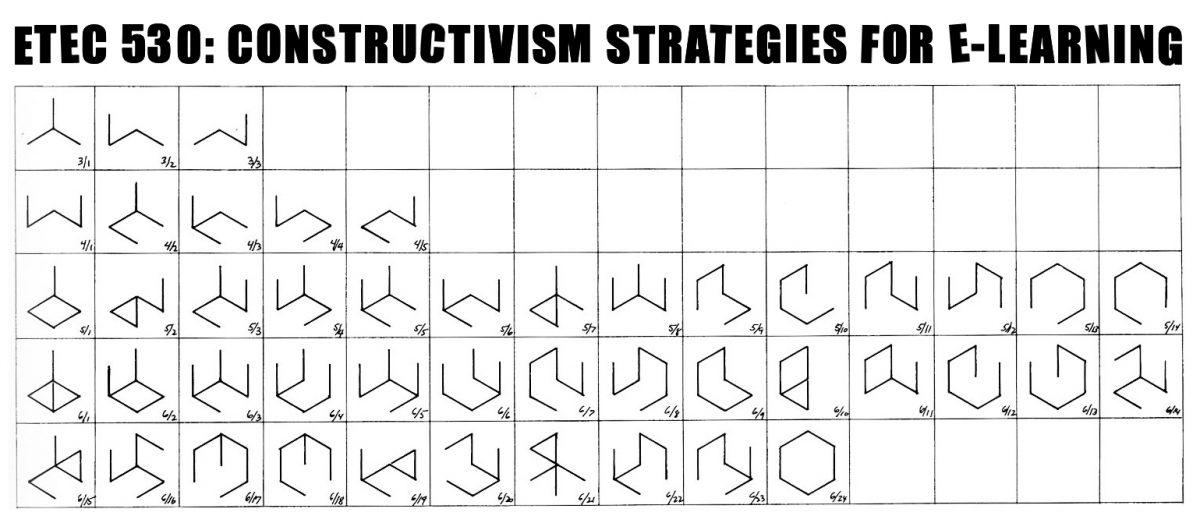A Constructivist Perspective on Teaching and Learning in the Arts, Maxine Greene (2013)
Greene’s (2013) chapter is a poetic read that weaves constructivism into ideas about classic art history, contemporary art, and critical theory. Early on she highlights a key aspect that art makes use of visual and multimodal languages, or “symbol system[s]” (p. 115), but that the meaning of art, in whatever form it takes, is fluid, in flux, “provisional” because through a constructivist lens, each who perceives it, including the artist, does so through their own unique lens. There is a tension that exists when the artist and viewer share understanding through the interpretation of the sign systems evident in the artwork, yet concurrently are disconnected from being able to ever grasp the other’s perspective fully. There’s something lonely, yet beautiful about this, Greene states, “we know that, in decoding Moby Dick or The House of Mirth or Invisible Man, we are in some sense reading the texts of our own lived lives” (p. 115). As if to counteract the isolation that comes with being trapped within oneself, Greene explains how through arts-based languages communities of practice grow and evolve,
In the realm of the arts, as in other realms of meaning, learning goes on most fruitfully in atmospheres of interchange and shared discoveries…To reach beyond is to realize that there exists a tradition and a community of knowers, of seekers, none of whom has the final answer to any question, all of whom are engaged in a communal construct of knowledge. (p. 116)
The chapter concludes with an uplifting take on the inherent isolation of our own observations of reality, particularly our observations of art. Greene’s position is to celebrate the multiplicity of understanding that we collectively hold, and that art can invite, “this process, this opening of possibilities and plurality of interpretation enriches the object, feeds its potentiality” (p. 128).
Perspectives into Learning at the Workplace, Päivi Tynjälä (2008)
In contrast to Greene’s writing, I also read a far more practical research review titled Perspectives into Learning at the Workplace written by Päivi Tynjälä (2008). As a fine arts graduate who works as an educator in a government office, the selection of these articles is directly reflective of my own lived experience. Interestingly Tynjälä also focuses prominently on the importance of communities of practice within the workplace and how integrating with work culture, networking, and becoming a contributing member of a work team is essential to success. In an almost laughable juxtaposition to Greene’s views, Tynjälä writes, “the ability to learn in collaboration with other people, both within and outside one’s organisation, often makes the difference between success and failure. Employees who cannot network with others to share and construct knowledge will fall visibly behind their peers in the possession of such abilities (Slotte & Tynjälä, 2003)” (p. 135). Although harsh, there is truth to this statement – relying on one’s singular perspective, without constructing a more robust understanding through information gathered socially, is a very limited way to learn.
Tynjälä also stresses that workplace learning is not the same as academic learning. She explains that “while informal learning occurs as a part of everyday work processes and activities and produces mainly implicit or tacit knowledge, formal learning takes place in the context of organised training and learning activities and is meant to generate explicit, formal knowledge and skills” (p. 140). The paper concludes with a recommendation that more formal learning structures be implemented into the workplace to balance the largely tacit or informal learning that is most prevalent. In reflection, my own workplace appears to have taken this advice and is mid-way through building a formal education structure for staff, in fact, the existence of my role is a part of this initiative.
A Statement on Education, Revisited
As such a strong proponent for social constructivism, it is hard to believe it was not the core theme of my initial statement, but at that time I was thinking more broadly, less practically.
Greene (2013) and Tynjälä’s (2008) texts turned my focus to social constructivism through communities of practice. Greene’s interpretation guides the reader to understand the depth of language systems within arts culture that contribute to a community of followers extended through history. Tynjälä’s description is localized to the microcosm of the workplace and suggests that joining a community of practice within a workplace can enhance and enrich learning, while failing to participate can lead to isolation and negatively affect performance. Although the delivery of each perspective varies significantly, both share the same sentiment that learning and experiencing socially are advantageous; that building perspectives that are aware and welcoming of a plurality of perspectives makes us more connected, whole people. In some ways, as a naturally social being, I have already implemented aspects of this concept with the group of learning staff I provide training and mentorship for, yet my attempts at community building has been somewhat unconscious. To approach my work with intentionality, and with a more informed notion of what a ‘community of practice’ might look like, allows me to further cultivate what has been initiated to provide more meaningful and connected learning for staff that benefits the department as a whole.
References
Greene, M. (2013). A Constructivist Perspective on Teaching and Learning in the Arts. In Fosnot, C. T. (Eds.), Constructivism: Theory, perspectives, and practice (2nd ed., pp. 110-131). Teachers College Press. https://ebookcentral.proquest.com/lib/ubc/detail.action?docID=3545062Links to an external site.
Tynjälä, P. (2008). Perspectives into learning at the workplace. Educational research review, 3(2), 130-154.
